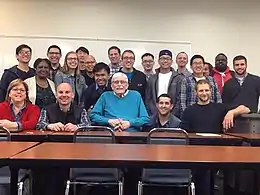Grant R. Osborne
Grant R. Osborne ( - )[1] est un théologien évangélique américain et spécialiste du Nouveau Testament. Il est professeur de Nouveau Testament à la Trinity Evangelical Divinity School.

| Naissance | |
|---|---|
| Décès |
(à 76 ans) Libertyville |
| Nationalité | |
| Formation |
Trinity Evangelical Divinity School (en) Université d'Aberdeen |
| Activité |
Biographie
Éducation
Il a étudié la mission chrétienne au Fort Wayne Bible College de Fort Wayne (Indiana) et a obtenu un Bachelor of Arts [2]. Puis il a étudié le Nouveau Testament à la Trinity Evangelical Divinity School de Chicago et a obtenu un master. Il a également étudié le Nouveau Testament à l'Université d'Aberdeen en Écosse et a obtenu un doctorat[2].
Carrière
Osborne enseigne au Winnipeg Theological Seminary et à l'université d'Aberdeen et est pasteur d'églises dans l'Ohio et l'Illinois[2]. De 1977 à 2016, il est professeur de Nouveau Testament à la Trinity Evangelical Divinity School[1][2].
Il se spécialise dans l'Herméneutique biblique, les Évangiles et le livre de l'Apocalypse[2]. Il est surtout connu pour son concept de « spirale herméneutique »,[3] désignant un « processus ascendant et constructif consistant à passer d'une pré-compréhension antérieure à une compréhension plus complète, et à revenir en arrière pour vérifier et revoir le besoin pour correction ou modification de cet accord préliminaire »[4].
Il est membre du comité de traduction de la Bible pour la New Living Translation[2]. Il est traducteur général pour les Évangiles et les Actes[2].
Il est membre de la Société de littérature biblique, de la Société théologique évangélique et de l'Institut de recherche biblique[2].
Théologie
Osborne a des vues sotériologiques arminiennes[5][6]. Dans A Classical Arminian View,[7] il écrit en faveur d'une apostasie possible pour le vrai croyant[8].
Publications
Livres
- Grant R. Osborne et Stephen B. Woodward, Handbook for Bible Study, Grand Rapids, MI, Baker Book House,
- Grant R. Osborne, The Resurrection Narratives: a redactional study, Grand Rapids, MI, Baker Book House,
- Grant R. Osborne, The Hermeneutical Spiral: A Comprehensive Introduction to Biblical Interpretation, Downers Grove, IL, 1st,
- Grant R. Osborne, Three Crucial Questions about the Bible, Grand Rapids, MI, Baker Book House, coll. « 3 crucial questions »,
- Grant R. Osborne, Revelation, Grand Rapids, MI, Baker Academic, coll. « Baker Exegetical Commentary on the New Testament »,
- Grant R. Osborne, Romans, Downers Grove, IL, IVP, coll. « IVP New Testament Commentary »,
- Grant R. Osborne, Matthew, vol. 1, Grand Rapids, MI, Zondervan, coll. « Zondervan Exegetical Commentary on the New Testament »,
- Grant R. Osborne, The Hermeneutical Spiral: A Comprehensive Introduction to Biblical Interpretation, Downers Grove, IL, Revised,
- Grant R. Osborne, Mark, Grand Rapids, MI, Baker Book House, coll. « Teach the Text commentary series »,
- Grant R. Osborne, Carl R. Trueman et John S. Hammett, Perspectives on the Extent of the Atonement: 3 views, Nashville, TN, B & H Academic, coll. « Perspectives »,
Ouvrages édités
- Grant R. Osborne et Scot McKnight, The Face of New Testament Studies: a survey of recent research, Grand Rapids, MI, Baker Academic,
- Grant R. Osborne, Jon C. Laansma et Ray Van Neste, New Testament Theology in Light of the Church's Mission: Essays in Honor of I. Howard Marshall, Eugene, OR, Cascade Books,
Chapitres
- (en) Grant R. Osborne, Four Views on the Warning Passages in Hebrews, Grand Rapids, MI, Kregel Publications, (lire en ligne), « A Classical Arminian View »
Festschrift
- Stanley E. Porter et Eckhard J. Schnabel, On the Writing of New Testament Commentaries: festschrift for Grant R. Osborne on the occasion of his 70th birthday, Leiden, Brill, coll. « Texts and editions for New Testament study »,
Notes et références
- (en) Cet article est partiellement ou en totalité issu de l’article de Wikipédia en anglais intitulé « Grant R. Osborne » (voir la liste des auteurs).
Citations
- McKnight 2018.
- TIU 2019.
- Melick 2013.
- Thiselton 2009.
- Whright 1996, p. 154. « Le traitement arminien typique des versets importants peut être trouvé dans les articles de Grant Osborne dans Clark Pinnock, ed., Grace Unlimited (Minneapolis: Bethany, 1975) et The grace of God, the Will of Man. »
- Osborne 2007, p. 7.
- Osborne 2007, p. 86-128.
- Allen 2010, p. 537. « Par définition, un arminien croit qu'il est possible pour un chrétien vraiment né de nouveau de perdre son salut. Les interprètes arminiens reconnaissent à juste titre que l'auteur des Hébreux s'adresse à ses lecteurs en tant que croyants tout au long de l'épître. [...] Grant Osborne, dans son chapitre "A Classical Arminian View" dans "Four Views on the Warning Passages in Hebrews", 86-128, informe ses lecteurs dans le deuxième paragraphe que Heb 6: 4-6 parle de vrais croyants qui commettent l'apostasie qui est le péché impardonnable, et ainsi perdent leur salut pour toujours. »
Sources
- (en) David L. Allen, Hebrews: An Exegetical and Theological Exposition of Holy Scripture, Nashville, B&H Publishing,
- (en) Richard R. Melick, In Defense of the Bible: A Comprehensive Apologetic for the Authority of Scripture, , « Can We Understand the Bible? », p. 114
- (en) McKnight, « Grant Osborne », Jesus Creed, Patheos, (consulté le )
- Anthony C. Thiselton, Hermeneutics: An Introduction, (lire en ligne), p. 14
- (en) TIU, « Professors Emeriti », Trinity International University, (consulté le )
- (en) R. K. McGregor Whright, No Place for Sovereignty: What's Wrong with Freewill Theism, Downers Grove, InterVarsity,